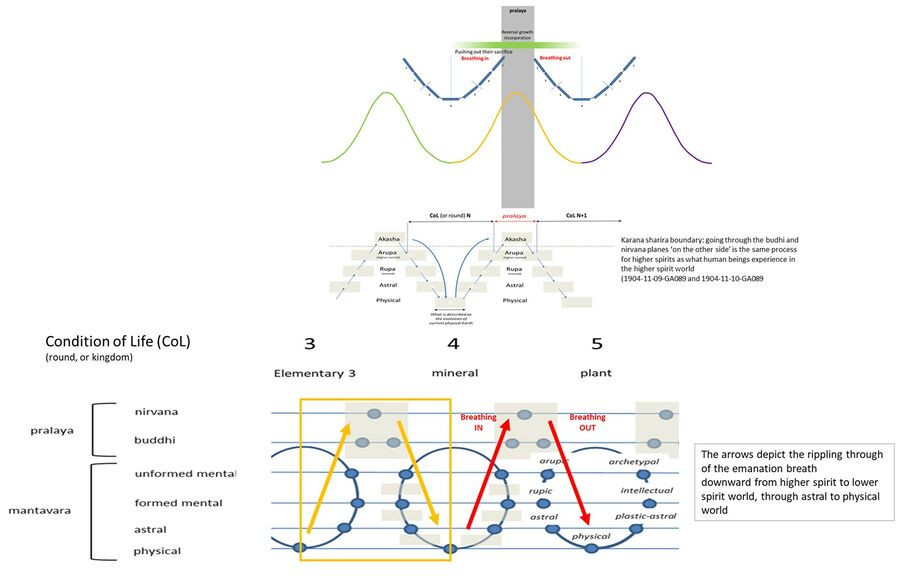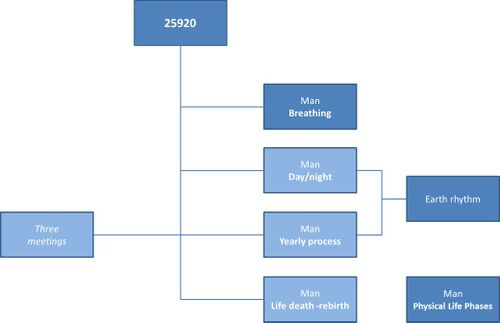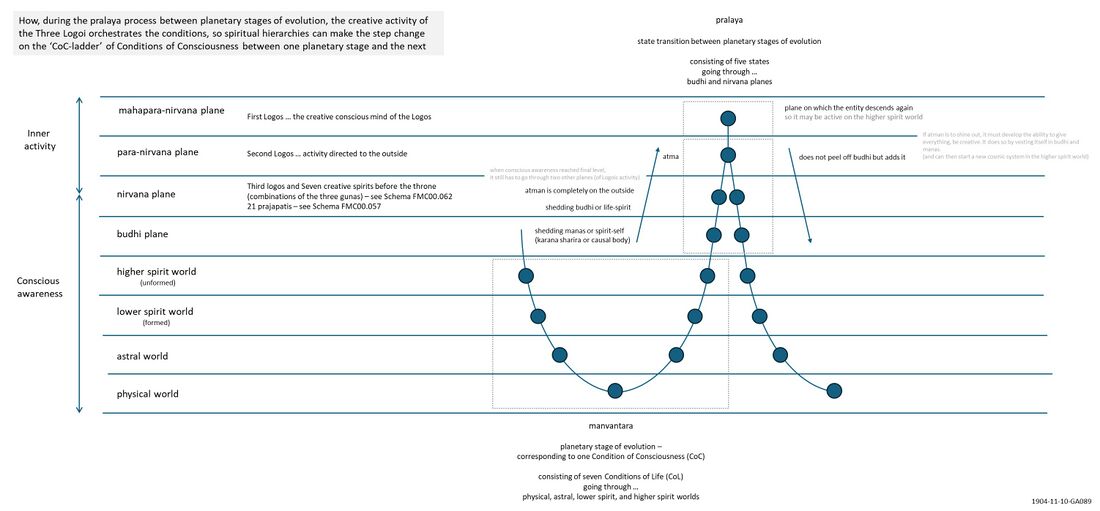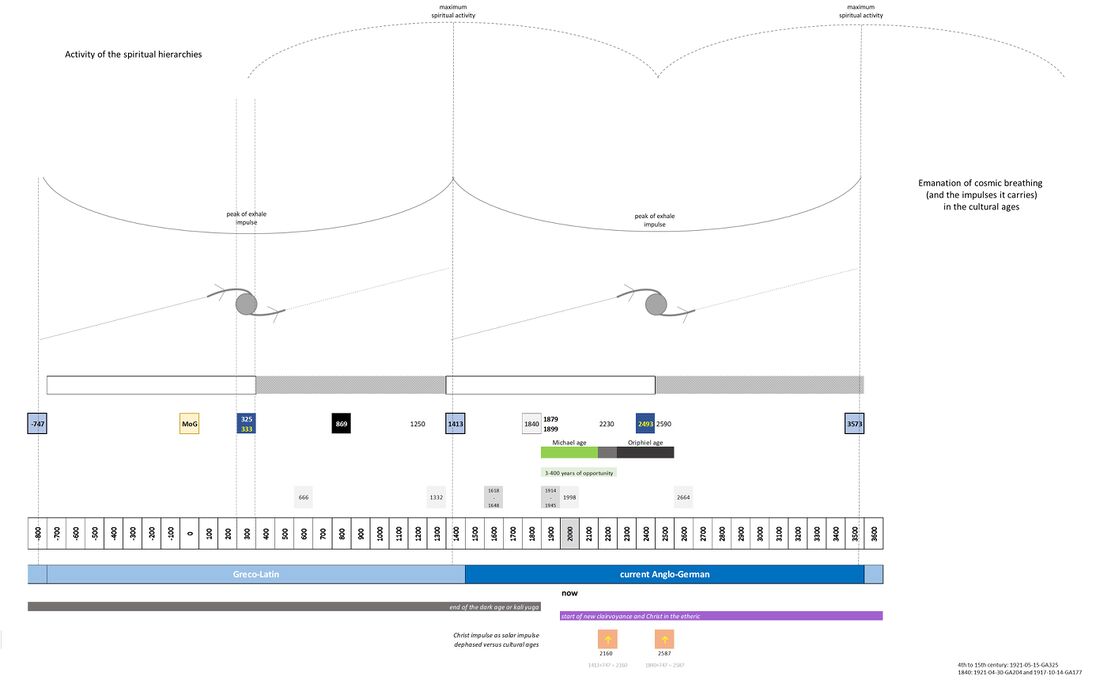Cosmic breathing
Rhythm is everywhere in nature, in the macrocosm and the microcosm, Man. The Golden Chain describes a spiritual scientific framework consisting of spiritual entities acting from and interacting between various worlds.
This section focuses on how this happens and how it is perceived from our human earthly perspective with sensory or waking consciousness, more specifically along the time dimension (see also Lemniscatory timespace), in the various rhythms in nature.
An introduction is offered by a juxtaposition of various themes:
- the rhythms of Man's life, from his breathing rhythm to the life cycle of Man, and how it is linked to the cosmic rhythm of Earth (day and night) and Sun (yearly) - this is symbolized by the number 25920 (see Schema FMC00.027 below)
- the microcosm perspective also includes the various rhythms in Man's physiological functioning and growth (heart rate to blood pulse, Seven year rhythm, etc).
- the macrocosm perspective includes the astronomical rhythms of the stars and planets
- the various spiritual hierarchies and their 'eigenperiods' how they map to different periods (archangels) cultural ages (archai), epochs (SoF).
- a subaspect is the perspective of the cosmic influences as described in the Golden Chain and the formative forces, the etheric formative forces working from the zodiac and planetary spheres. See also a.o. Planetary hours
- at planetary evolutionary level, the dynamic of the different planetary stages and Conditions of Consciousness with Conditions of Life and Form, the mantavaras and pralayas. See also Schema FMC00.093 below, and explanation on Three dimensions of evolution.
- at the highest level the great cycle of a solar system evolution with seven planetary stages of evolution (and corresponding Conditions of Consciousness)
The common theme in the above, is that of an in- and outbreathing rhythm that is part of a great cosmic fractal dynamic whereby all spiritual entities are in continuous evolution, and various of such breathing rhythms take place at different levels. All this is covered in more detail in other topic pages on this site (see links). The goal here is to integrate and take a meta-perspective to develop an imagination of the eternal dynamic in the macrocosmos by seeing in our soul how all the above are linked. Thereby feeling ourselves into the fact that we can transpose our human breathing and development process to the other hierarchies and the different stages of evolution, and that we are part, as a microcosm, of that great macrocosmos (also described under Cosmic fractal).
Aspects
1 - 25920 - the rhythm of Man, and how it is linked to the cosmic rhythm of Earth and Sun
The cosmic rhythm can be introduced through the number 25920 by considering:
- the rhythm of the human breath (editor: average of 25920 breaths in a day)
- the Rhythm of a day and one earth breath - day and night (editor: 25920 days in an average human life)
- the Rhythm of a year, the four seasons, the great festivals
- Man's cycle of reincarnation, of life between birth and death, and between death and re-birth, whereby each life represents one breath of a 'Great Being that breathes us in and out, again in a rhythm determined by the number 25920 - the sun's course around the Zodiac in 25920 years or one platonic year
- the 'three meetings': Man has three touchpoints with his higher Self: one is daily (Spirit Self), one yearly (Life Spirit) and the third once in a human life (Spirit Man), that connect (b) and (c) and (d)
2 - Spiritual hierarchies and their eigenperiods
This section is a summary, for more info see the page for: Spiritual hierarchies and their eigenperiods, also for info on the term 'eigenperiods'. The term 'eigenperiod' for the type period that defines the rhythm characteristic for any particular spiritual hierarchy.
- archangels (or folk spirits): rule three to four centuries, an average of 354 years
- archai (or spirit of the age (or zeitgeist)): one cultural age of approx 2160 years. Rather than the human earthly unit of 'year', the Zodiac clock is used (and/or the Platonic year).
- spirits of form (SoF)
- spirits of motion (SoM)
- spirits of cyclic periods (give order to the folk spirits)
3 - Planetary stage dynamic with Conditions of Life and Form, mantavaras and pralayas
This is discussed in more detail in the Evolution section, this however summarizes it in the contextual perspective of Cosmic Breathing.
The three logoi correspond to three levels of a great cosmic rhythm that is rolling off at
- the level of state or Condition of Consciousness, corresponding to a planetary stage
- then the various Conditions of Life (CoL)
- then the various Conditions of Form (CoF)
A simple twodimensional visualization of the process of mantavaras and pralayas of the seven planetary stages in this cycle of our solar system, can be felt as a cilinder going up and down, an exhalation from the higher nirvana plane down via buddhi plan and spirit land .. and then an inhalation again whereby all that got created in the exhalation makes it way up again and is sucked up and into its highest spiritual essence (see also the concept of the Occult atom.
At the highest level of Creation by the three Logoi, a chain with a cycle of planetary incarnations such as our solar system evolution, is also breathed in and out. This is called as the Cosmic breath of Brahma.
4 - Other rhythms
- 154 year periods: are mentioned in 1924-09-17-GA346 where the seven seals and trumpets are linked to the MoG, crusades, 1843-44 and the end of the 20th century, see Book of Revelation#1924-09-17-GA346. See visual Schema FMC00.611 - middle.
- 500 years: Group souls of humanity: the symbol of the phoenix (see Schema FMC00.470): current human group souls, and how they cyclically regenerate (hence 'phoenix') with a lifecycle of approx. 500 years (1907-12-27-GA101, also Ovid).
- 600 years: six hundred year long waves of cultures, see Reconquista#1911-03-13-GA124. See visual Schema FMC00.611 - right.
- 800 years: Schema FMC00.490 on Christ in the future cultural ages and next epochs shows how the human thought about Man and the cosmos, or philosophy, evolves in periods of approx. 800 years related to the sun laws. These 800 years periods also appear on Schema FMC00.376A on the same page
- 12.000 years: Cosmic year of Zarathustra of 12.000 earth years, see Schema FMC00.013 and 1915-12-31-GA165
Inspirational quotes
Goethe speaks of the ‘Brother Spheres’ in the preface 'Prologue in heaven', where he starts with Raphael
Still quiring as in ancient time .. With brother spheres in rival song,
The sun, with thunder march sublime, .. Moves his predestined course along.
Angels are strengthened by his sight, .. Though fathom him no angel may;
Resplendent are the orbs of light, .. As on creation's primal day.
other translation
With thunder-march, his orb completing, .. Moves his predestin’d course along;
His aspect to the powers supernal, .. Gives strength, though fathom him none may;
The lofty works, past comprehending,.. Stand lordly, as on time's first day.
Transcending thought, the works eternal, .. Are fair as on the primal day.
Illustrations
Schema FMC00.170 sketches the polarity between 'center and periphery' and 'pralaya and mantavara', see also Cosmic breath of Brahma which denotes the same, the highest level of in- and out-breathing that gives rise to all of creation.

Schema FMC00.240A puts the above in perspective and shows how this corresponds to the cosmic breathing pattern

Schema FMC00.655: depicts the process between planetary stages of evolution, a process impacting all spiritual hierarchies.
It illustrates how the creative activity of the Three Logoi orchestrates the conditions, so spiritual hierarchies can make the step change on the ‘CoC-ladder’ of Conditions of Consciousness (Schema FMC00.048) between one planetary stage and the next.
Note: see commentary in Discussion note on the question how this differs between different planetary stages (Schema FMC00.414 and variants) or a maha-pralaya. For a start, see Schema FMC00.564 (together with Schema FMC00.329) for a visualization that the CoC-ladder is extended as spiritual hierarchies are added and evolve, so this is an additional (growth) dynamic to be superimposed on the process shown here.
Schema FMC00.027 gives an overview of the various rhythms in nature and Man coupled to the number 25920:

Schema FMC00.093 gives an overview of the different dimensions that roll off in one another in the great cosmic evolution

Schema FMC00.035 quotes the Bhagavad Gita to describe classes of elementals linked to the rhythms of the year (sun), the month (moon), and day (earth)

Schema FMC00.534: is a schema intended to support study of the fourth and fifth cultural ages and gain insights of the patterns underlying evolutionary development of humanity, see also Schema FMC00.059 on History. This schema has:
- a) a lower section with key dates and phases described in Rudolf Steiner's lectures, and focus on i) the period of the 4th century (see also 325) and the Transition between 4th and 14th century (including aspects such as Central European cultural basin and Migrations but also 869, the Christ Impulse - meeting of two streams, Academy of Gondishapur, and more); and ii) the period 1840 and it's relation to the new start in the age of the consciousness soul (see 1840 and 1879)
- b) an upper section showing the inhale-exhale cycle of cosmic breathing and the two halves of an evolutionary cycle related to this. In this case focus is on a cultural age corresponding to an archai time spirit, whereby certain centuries or periods represent crucial transitions on the timeline of the development of mankind. History and evolution does not progress linearly but with jumps or step changes represented by the spiral symbol. This is linked to the activity of spiritual activities (above) and their emanation that can be observed (below).
- For example: the year 333 is described (in 1918-10-16-GA182) as the time the intellectual soul was coming to its prime, up to then it was developing on the ascending arc, then began the arc of descent.
Notes
- Discussion Note The two halves of an evolutionary cycle#Note 1 - First and second half of a cultural age provides a narrative to the schema with explanations and relevant lecture excerpts and references, to explain the point the schema conveys, and how it helps to understand the 'jump' in Schema FMC00.535.
- See also related Schema FMC00.052 and Schema FMC00.052A.
- Regarding the pivotal importance of the 4th century for worldview, see also Mystery School tradition#Note 1 - Regarding the timing of the "college for destruction of initiation and spirit" and related Threefold Sun#Note 2 - The Palladium as a symbol of the secret of the sun
- For purposes of personal study, this scaled down image on the site can be saved as high resolution JPG file and printed on A3 format for readability, so one can add personal annotations.
Lecture coverage and references
1908-12-21
Rhythm is implanted in matter by the spirit, Man has rhythm as a legacy of his spiritual origins.
1909-01-12
And the whole of human nature would become dear to us exactly through these rhythms, through the mysterious internal arrangements.
1918-10-12
You only have rhythmic processes in nature, none that go on ad infinitum; you only have something that rhythmically returns to itself again... If people ever give up looking for things immediately apparent to the senses and make this the basis of our natural world, they will discover something very different. They will find rhythms everywhere in nature, rhythmic arrangements... The whole of life is rhythmic. True science will be to penetrate the rhythms in nature.
1913-12-31-GA149 talks about Zervan Akarana – the workings of time .. 12 month and 30 day beings
.. associate the Zarathustrian world-picture with “Chronology”: it looks beyond the two Beings, Ahura Mazdao and Ahriman, to the workings of Time — Zervan Akarana.
Not the abstract Time we think of today, but Time viewed as a living, super-personal Being. From this Being proceed the rulers of Time;
- first of all the Amshaspands, the spiritual Beings who are symbolised in cosmic space by the signs of the Zodiac. Through the number six — or twelve if we reckon in their antipodes — they rule over
- the Izeds, who rank below them and are 28–31 in number. The Izeds are spirits of a lower kind, servants of the high Time Beings; they regulate the days of the month.
The Zarathustrian consciousness looked at the wonderful harmony which works through forces and is symbolised numerically by all the relations and combinations which result from the interweaving of 28 to 31 with 12. It looked into all that streams into the world and resounds through it, because in the great world-orchestra the instruments sound harmoniously together in these numerical relationships. For the Zarathustrian world-picture this appears as the ordering and harmonising principle in the cosmic order. ... And because in that which creates, and nourishes itself in creating, in that which takes the world-pictures into itself, absorbing them spiritually and carrying them over to higher stages — because the Zarathustrian outlook sees in “Time” something living and super-personal — so, while spiritualising the term, we may call this world-picture “Chronology”, whereby we are led to think at once of the god Kronos, the Regent of Time. ...
.. And what followed in Greece or in the Graeco-Latin epoch? .. the Greeks reverenced Apollo, the reflection of the Nathan Jesus-child as he had been at the end of the Atlantean time. It was out of the Hyperborean land, from the North, that Apollo came to the Oracle at Delphi. Through the Pythia, in summer, he spoke the most important things that the Greeks wished to hear. In the autumn he returned to his Hyperborean land. We connected this journey of Apollo with the journeys of the sun; but it is the spiritual sun that speaks through Apollo, and the spiritual sun goes away to the north, while the physical sun goes to the south. The myths are seen to be endlessly full of wisdom if they are considered in the light of true occultism. But in revering Apollo the Greeks did not look on the sun as his visible sign in the heavens; Apollo was not a sun god in this sense. For a god symbolised by the external sun the Greeks had Helios; it was he who regulated the course of the sun in the sky.
Even if we take only the physical sun into account, we find that its influence on earth-life is not confined to the direct effects of its rays. The sun works in the first place through air and water and water-vapour, and so through the vapours which (as we have seen) rise from the site of the Castalian spring and coil round the neighbouring hillsides like a dragon — the dragon killed by the Greek St. George. The sun works in all the elements, and after it has worked into them, inoculated them, its activity plays out from them on to human beings, through the servants whom we call elemental spirits. In the elements the Sun-Spirit is actively alive, and this is the activity the Greeks saw in their Apollo.
Thus for the Greeks Apollo was a sun god, but not the Helios who drove the chariot of the sun across the heavens and to some extent regulated the times of the day. In Apollo the Greeks saw the sun's activity in the atmosphere, and this activity they addressed as Apollo when they addressed it spiritually. And so it was with many gods and spiritual beings whom we find in the West. I could mention many, but we need point only to Wotan with his wild host, rushing through the storm.
1923-07-20-GA350: human and cosmic breathing, the Earth breathes light
Discussion
Note 1 - Russell's voidance principle
From the work of Walter Russell
“All things are voided as they occur, repeated as they are voided and recorded as they are repeated.”
The voidance principle states that 'all things', shorthand for the reality around us, and the whole cosmos, is in a continuous state of dynamic. That as it 'occurs', meaning as its emanation reaches its final state, it goes back into being voided.
Now compare this with the cycle of Cosmic breathing that takes place, in and out, to a certain Condition of Consciousness, Life, Form (CoC, CoL, CoF).
DRAFT WIP - to be added:
- within Man, the subsystems in the microcosm are related to the macrocosm and the rhythms also have their interrelationships. Examples are the 4:1 rhythm between the blood pulse and the breathing; an Electrocariogram to monitor the heart activity, the 'heart rate variability' (HRV). See eg Hildebrandt under 'Further Reading' below
Related pages
- Christ Module 17 - The experience of the year
- Rhythm of a day
- Rhythm of a year
- Eighteen year rhythm
- 25920
- Cosmic breath of Brahma
- Three dimensions of evolution
- Planetary hours
- Cosmic fractal
References and further reading
- Johannes Kepler: 'Harmonice Mundi' (1619)
- H. Spencer Lewis: '(Self mastery and fate with the) Cycles of life' (1929)
- Arnold Krumm-Heller: 'Biorritmo (1930)
- Gunther Wachsmuth: 'Erde und Mensch: Ihre Bildekräfte, Rhythmen, und Lebensprozesse' (1945)
- Wilhelm Hoerner: 'Zeit und Rhythmus - die Ordnungsgesetze der Erde und des Menschen' (1978, fifth edition 2006)
- Albert Riedel (Frater Albertus):
- The seven rays of the QBL (1967)
- From one to ten (1966)
- Gunther Hildebrandt (1924-1999)
- Die rhythmische Funktionsordnung von Puls und Atmung (1958)
- Biologische Rhythmen Und Arbeit: Bausteine Zur Chronobiologie Und Chronohygiene Der Arbeitsgestaltung (1975)
- Medizinische Rhythmusforschung' in 'Rhythmen des Lebens' (1983)
- 'Need for Rhythm Studies in Anthroposophic and Goethean Science' (1996), as part of the 'Rhythm in Cosmos, Earth and Man' conference, organized by the Medical Section and the Astronomy Section at the Goetheanum
- for more on Chronobiology, see the Carus Institute
Additionally
- See also Schultz, Vreede on Astronomy


